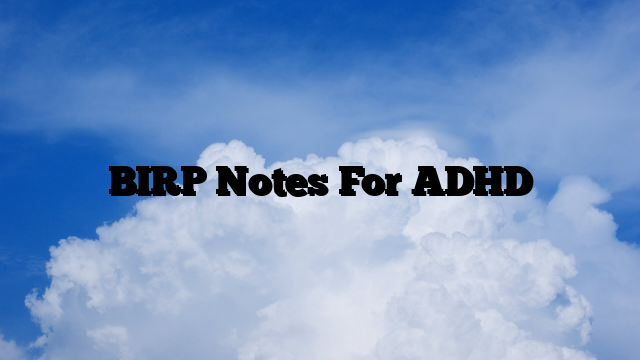BIRP notes can have a very significant role in managing ADHD. Attention-Deficit/Hyperactivity Disorder, commonly known as ADHD, presents unique challenges in both diagnosis and treatment. Through this post, we will shed light on how the BIRP (Behavior, Intervention, Response, Plan) note-taking system can be a game-changer for clinicians and patients alike. From documenting specific behaviors and interventions to tracking responses and adjusting treatment plans, BIRP notes offer a structured approach to understanding and managing ADHD. Whether you’re a healthcare professional, a patient, or simply someone interested in mental health care, this blog will provide valuable insights into the practical applications of BIRP notes in the effective management of ADHD.
BIRP Note Structure For ADHD
Here’s a brief overview of how BIRP notes might be structured for an ADHD patient:
- Behavior: Document the specific behaviors observed that are related to ADHD. This could include inattention, hyperactivity, impulsivity, or difficulty in organizing tasks. For instance, “The patient had difficulty staying focused on a single task and was easily distracted by external stimuli.”
- Intervention: Record any interventions or strategies used during the session or prescribed for managing ADHD symptoms. This may include behavioral strategies, psychoeducation, medication, or cognitive-behavioral techniques. For example, “Implemented a time management strategy to help the patient focus on tasks for a set period.”
- Response: Note the patient’s response to the interventions. This includes both their behavior during the session and any feedback they provided. For instance, “The patient reported feeling more organized with the use of a planner and showed improvement in completing tasks.”
- Plan: Outline the plan for future sessions or recommendations for the patient to continue managing their ADHD. This might include continuing certain interventions, trying new strategies, or adjusting medications. For example, “Plan to continue focusing on time management techniques and consider medication adjustment in collaboration with the psychiatrist.”
BIRP Note Examples For ADHD
Example 1
Here’s an example of how BIRP notes might look for a patient with ADHD:
B – Behavior
- Patient displayed noticeable difficulty in maintaining attention during the session. They were easily distracted by noises outside the room.
- Exhibited signs of restlessness, frequently fidgeting and unable to sit still for more than a few minutes.
- Struggled to follow the conversation, often diverting to unrelated topics.
I – Intervention
- Engaged the patient in a focused discussion about their attention challenges, using direct, short questions to maintain engagement.
- Introduced a simple organizational tool, a daily planner, to help the patient in structuring their day and managing tasks.
- Discussed the possibility of incorporating mindfulness exercises to help with focus and reduce restlessness.
R – Response
- The patient responded positively to the direct questioning, showing increased ability to focus during these times.
- Expressed enthusiasm about using the daily planner, noting they have never tried this approach before.
- Showed interest in mindfulness exercises, though was skeptical about their ability to sit still for meditation.
P – Plan
- In the next session, plan to review the patient’s experience using the daily planner and adjust the tool as needed.
- Introduce brief, guided mindfulness exercises, starting with very short durations to accommodate the patient’s restlessness.
- Continue to use direct questioning techniques to maintain the patient’s engagement in sessions.
- Consult with the patient’s psychiatrist regarding the current medication regimen and its effectiveness in managing ADHD symptoms.
This example demonstrates how BIRP notes are used to record specific behaviors related to ADHD, interventions employed during the session, the patient’s response to these interventions, and the future plan for treatment.
Example 2
Here is another specific example of how BIRP notes can be used for ADHD:
- Behavior: A child with ADHD is having difficulty focusing in school and is often fidgeting and getting out of their seat.
- Intervention: The child’s teacher starts using a token economy system to reward the child for staying focused and on task.
- Response: The child’s focus improves and they are getting out of their seat less often.
- Plan: The teacher continues to use the token economy system and gradually increases the length of time the child needs to stay focused to earn a reward.
BIRP Note Template for ADHD
Here’s a template of BIRP notes for ADHD:
Date: January 3, 2024
Client: John Smith, 10-year-old male
Diagnosis: ADHD, combined presentation
BIRP Notes
B: Behavior
- John is having difficulty completing tasks in class and at home.
- He is often easily distracted and gets off-task.
- He has trouble staying seated for long periods of time and frequently fidgets or gets up to move around.
- He interrupts others often and has difficulty waiting his turn.
I: Intervention
- Continued medication management with methylphenidate (Ritalin), 10 mg twice daily.
- Weekly individual therapy sessions focused on cognitive-behavioral strategies for managing ADHD symptoms.
- Daily behavior report card from teacher to monitor progress in school.
- Parent training sessions to teach effective behavior management techniques at home.
R: Response
- John has shown moderate improvement in his ability to focus and complete tasks in class and at home.
- He is still easily distracted at times, but he is better able to redirect his attention when prompted.
- His fidgeting and out-of-seat behavior have decreased somewhat.
- He is still working on interrupting less and waiting his turn.
P: Plan
- Continue current medication regimen.
- Continue individual therapy sessions with a focus on executive functioning skills and social skills training.
- Increase communication between parents and teacher to ensure consistency in behavior management across settings.
- Consider additional accommodations in the classroom, such as preferential seating or extra time for assignments.
- Reassess progress in 4 weeks.
Additional Notes
- John’s parents report that he is doing better at following instructions at home.
- John’s teacher reports that he is still struggling with completing homework on time.
- John is starting to express frustration with his ADHD symptoms and how they are affecting his schoolwork and friendships.
Clinician Signature: ________________
Tips for writing BIRP notes for ADHD
Here are some additional tips for writing BIRP notes for ADHD:
- Use specific and observable behaviors.
- Be clear about the interventions that are being used.
- Track the client’s response to the interventions over time.
- Set realistic goals for the client.
- Be flexible and willing to adjust the interventions as needed.
Conclusion
The use of BIRP notes in the management of ADHD is an invaluable tool, offering a structured and systematic approach to treatment. This method not only enhances the understanding of the patient’s specific challenges and responses to various interventions but also fosters a collaborative and dynamic treatment plan. By meticulously documenting behaviors, interventions, responses, and future plans, BIRP notes enable healthcare providers to deliver more personalized and effective care. For individuals with ADHD, this can lead to improved symptom management, increased self-awareness, and a better overall quality of life. As we continue to explore and refine approaches to mental health care, the significance of comprehensive and adaptive methods like BIRP notes cannot be overstated in contributing to successful patient outcomes.






